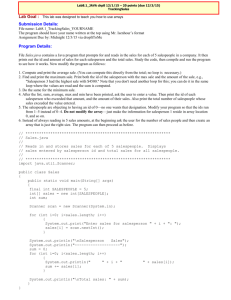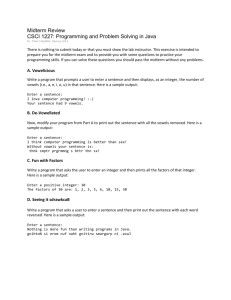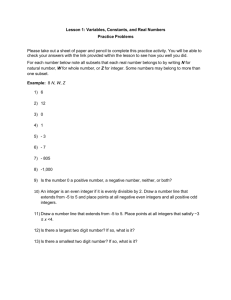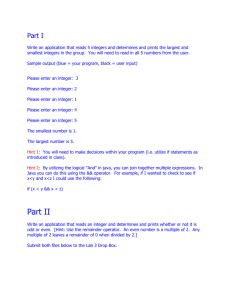For Exercises 4.11 through 4.14, perform each of these steps: a
advertisement
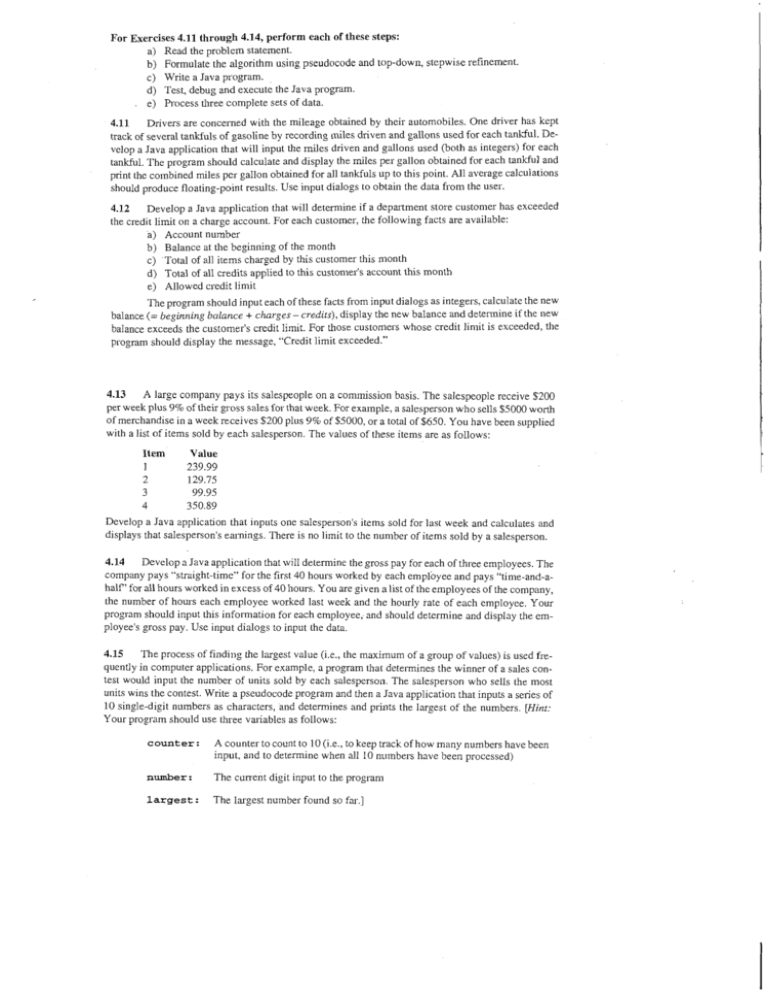
For Exercises 4.11 through 4.14, perform each of these steps:
a) Read the problem statement.
b) Formulate the algorithm using pseudocode and top-down, stepwise refinement.
c) Write a Java program.
d) Test, debug and execute the Java program.
. e) Process three complete sets of data.
4.11 Drivers are conceined with the mileage obtained by their automobiles. One driver has kept
track of several tankfuls of gasoline by recording 11ules driven and gallons used for each tankful. Develop a Java application that will input the miles driven and gallons used (both as integers) for each
tankful. The program should calculate and display the miles per gallon obtained for each tankful and
print the combined miles per gallon obtained for all tankfuls up to this point. All average calculations
should produce floating-point results. Use input dialogs to obtain the data from the user.
4.12 Develop a Java application that will determine if a department store customer has exceeded
the credit limit on a charge account. For each customer, the followiilg facts are available:
a ) Account number
b) Balance at the beginning of the month
c) 'Total of all items charged by this customer this month
d) Total of all credits applied to this customer's account this month
e) Allowed credit limit
The program should input each of these facts from input dialogs as integers, calculate the new
balance (= 6eginn.irzg bnlarzce + clzarges - credits), display the new balance and determine if the new
balance exceeds the customer's credit limit. For those customers whose credit limit is exceeded, the
program should display the message, "Credit limit exceeded."
4.13 A large company pays its salespeople on a commission basis. The salespeople receive $200
per week plus 9% of their gross sales for that week. For example, a salesperson who sells $5000 worth
of merchandise in a week receives $200 plus 9% of $5000, or a total of $650. You have been supplied
with a list of items sold by each salesperson. The values of these items are as follows:
Item
Value
I
239.99
2
129.75
3
99.95
4
350.89
Develop a Java application that inputs one salesperson's items sold for last week and calculates and
displays that salesperson's emings. There is no limit to the number of items sold by a salesperson.
4.14 Develop a Java application that will determine the gross pay for each of three employees. The
company pays "straight-time" for the first 40 hours worked by each emplbyee and pays "time-and-ahalf' for all hours worked in excess of 40 hours. You are given alist of the employees of the company,
the number of hours each employee worked last week and the hourly rate of each employee. Your
program should input this information for each employee, and should determine and display the employee's gross pay. Use input dialogs to input the data.
4.15
The process of finding the largest value (i.e., the maximum of a group of values) is used frequently in computer applications. For example, a program that determines the winner of a sales contest would input the number of units sold by each salesperson. The salesperson who sells the most
units wins the contest. Write a pseudocode program and then a Java application that inputs a series of
10 single-digit numbers as characters, and determines and prints the largest of the numbers. [Hint:
Your program should use three vaiables as follows:
counter:
A counter to count to 10 (i.e., to keep trackof how many numbers have been
input. and to determine when d l 10 numbers have been processed)
number:
The current digit input to the program
largest :
The largest number found so far.]
4.16
Write a Java application that utilixs looping to print Lhe following table of values:
,'
Using an approach similar to Exercise 4.15, find the hvo largest values of the 10 digits en4.17
tered. (Note: You may input each number only once.)
Modify the program in Fig. 4.11 to validate its inputs. On any input, if the value entered is
4.18
other than 1 or 2, keep looping until the user enters a col~ectvalue.
4.19
What does the following program print?
public class Mystery2 {
public static void main( String args[] )
{
int count = 1;
while ( count <= 10 ) {
System.out.println( count % 2 == 1 ?
11****11
4.20
What does the following program print?
:
11++++++++11
);
-
public class Mystery3 {
public static void main( String args[] )
{
int row = 10, column;
while ( row >= 1 ) {
column = 1;
while ( coluxnn <= 10 ) {
System.out.print( row % 2 == 1 ? " < "
++column;
1
--row;
:
w>u
);
4.21 (Dangling-Else Problenz) Determine the output for each of the following when x is 9 and y
is 11 and when x is 11 and y is 9. Note that the compiler ignores the indentation jn a Java program.
Also, the Java compiler always associates an else with the previous if unless told to do olheiwise
by the placement of braces (C 1). Because, on first glance, the programmer may not be sure which if
an else matches, this is referred 10 as the "dangling-else" problem. We have eliminated the iildcntation from the following code to make the problem more challenging. (Hint: Apply indentation conventions you have learned.)
a) if ( x < 10 )
if ( y > 1 0 )
System.out.println( " * * * * * "
else
System.out.println( " # # # # # "
System.out.println( " $ $ $ $ $ "
b ) i f ( x < l O )C
if ( y > 1 0 )
System.out.println( " * * * * * "
);
);
);
);
>
else C
System.out.println(
System-out.println(
1
'I#####"
1;
"$$$$$'I
);
4.22 (Alzotlier Dangli~zg-ElseProblem) Modify the following code to produce the output shown.
Use proper indentation techniques. You may not make any changes other than inserting braces and
changing the indentation of the code. The compiler ignores indentation in a Java program. We have
ehmulated the indentation from the following code LO make the problem inore challenging. [Note: It
is possible that no niudification is necessary.]
i f ( y = = 8 )
if ( x = = 5 )
System.out.println(
else
System.out.println(
System.out.println(
System.out.grintln(
"@@@@@"
);
"#####" );
"$$$$$' );
"&&&ti&"
);
a) Assuming x = 5 and y = 8, the following output is produced.
bj Assuming x = 5 and y = 8, the following o u t p ~is
~ tproduced.
cj Assurnin:: x = 5 and y = 8, the following vulput is produced.
d ) Assuming x = 5 and y = 7.the following output is produced. LVote: The last three output
stu~ementsaller the else are all part of a compoulld stateinm1.J
Write an applet that reads ic the size of the side of a square and displays a hollow square of
4.23
*,at size out of asterislc:: using the arirv~stringmethod inside your applet's paint method. Use
an inpui dialog t.o read thc size fi.om the user. Your program should work For squares of all side sizes
betwze~l1 and 20.
A palindrome is a ~lliinberor a text phrase that reads the same backward as forward. For ex4.24
ample, each of thc fol!uwing five-digit integers are palindromes: 12321, 55555, 45554 and 11611.
%',it\: an application that reaiis in a five-digit integer and determines whether or not it is a palindrome.
!I the number is nut fjve digits, display an error message dialog indicating the problem to the user.
W'nm the user dismisses the error dialog, allow the user to enter a new value.
Write an appiicatior; that inputs an integer containing only 0s and 1s (i,e., a "binary" integer)
4.25
and print its deci~nalequivalent. (Hint: Use the mod~~lus
and divisioil operators to pick off the "binary" numl)t.r's digits or:e at n tirnc h.om light to left. J~tstas in the decimal number system where the
rightmost digit has a positional value of 1 and the next digit left has a positional value of 10, then 100,
then 1000, etc., in the binary number system the rightinost digit has a positional value of 1. the next
digit left has a positional value of 2, then 4, then 8, etc. Thus the decimal number 334 can be interp r e t e d a s 4 * 1 + 3 ~ l 0 + 2 " 1 0 0 . T h e d e c i m a l e q ~ ~ i v a l e n t o f b i n a1101is
ry
1*1+0*2+ 1 *4+1
*8or 1 +0+4+8or13.)
4.26
Write an application that displays the following checkerboard pattern:
Your program may use only three output statements, one of the form
System.out.print(
"* "
);
one of the form
S y s t e m - o u t .print (
"
'
);
and one of the form
Note that the preceding statement indicates that the program should output a single newline character
to drop to the next line on the output. (Hint: Repetition structures are required in this exercise.)
4.27
Write an application that keeps displaying in the command window the inultiples of the integer 2, namely 2,4, 8, 16, 32, 64, etc. Your loop should not terminate (i.e., you should create an infinite loop). What happens when you run this program?
4.28
What's wrong with the following statement? Provide the correct statement to add one to the
sum of x and y.
4.29
Write an application that reads three nonzero values entered by the user in input dialogs and
determines and prints if they could represent the sides of a triangle.
Write an appIication that reads three nonzero integers and determines and prints if they could
4.30
be the sides of a right triangle.
A coinpany wants to transmit data over the telephone, but they are concerned that their
4.31
phones may be tapped. All of their data is transmitted as four-digit integers. They have asked you to
write a program that will encrypt their data so that it may be transmitted more securely. Your application should read a four-digit integer entered by the user in an input dialog and encrypt it as follows:
Replace each digit by (tlze sum of that digitplus 7) nzodcilus 10. Then swap the first digit with the third,
and swap the second digit with the fom-th. Then print the encrypted integer. Write a separate application that inputs an encrypted four-digit integer and decrypts it to form the original number.
,
4.32 The factorial of a nonnegative integer 12 is written n! (pronounced "n factorial") and is defined
as follows:
n! = rz . (n - 1) . (n - 2) . ... . 1 (for values of n greater than or equal to 1)
and
n! = 1 (for n = 0).
Fo~.example,5 ! = 5 .4.
3 . 2 - 1, which is 120.
a) Write an application that reads a nonnegative integer from an input dialog and computes
and prints its factorial.
b) Write an application that estimates the value of the mathematical constant e by using the
formula
c) Write an application that computes the value of 8by using the foimula:
2
X
X
l!
2!
ex = I + - + - + - +
X
3
3!
...

